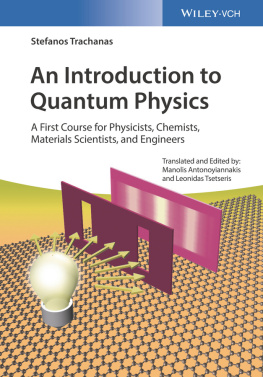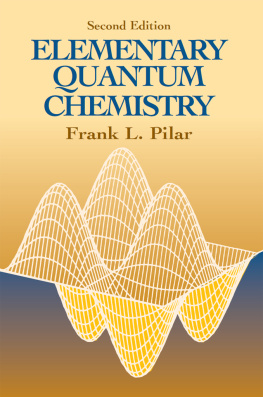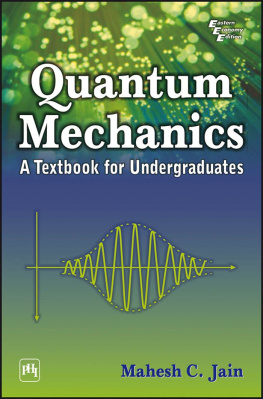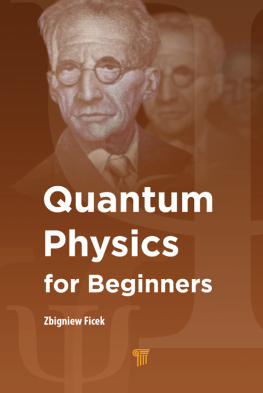
Authors
Stefanos Trachanas
Foundation for Research & Technology-Hellas (FORTH)
Crete University Press
100 Nikolaou Plastira
Vassilika Vouton
70013 Heraklion
Greece
and
University of Crete
Department of Physics
P.O. Box 2208
71003 Heraklion
Greece
Manolis Antonoyiannakis
The American Physical Society
Editorial Office
1 Research Road
Ridge, NY 11961
United States
and
Columbia University
Department of Applied Physics & Applied Mathematics
500 W. 120th Street
New York, NY 10027
United States
Leonidas Tsetseris
National Technical University of Athens
Department of Physics
Zografou Campus
15780 Athens
Greece
All books published by Wiley-VCH are carefully produced. Nevertheless, authors, editors, and publisher do not warrant the information contained in these books, including this book, to be free of errors. Readers are advised to keep in mind that statements, data, illustrations, procedural details or other items may inadvertently be inaccurate.
Library of Congress Card No.: applied for
British Library Cataloguing-in-Publication Data
A catalogue record for this book is available from the British Library.
Bibliographic information published by the Deutsche Nationalbibliothek
The Deutsche Nationalbibliothek lists this publication in the Deutsche Nationalbibliografie; detailed bibliographic data are available on the Internet at http://dnb.d-nb.de.
2017 Wiley-VCH Verlag GmbH & Co. KGaA, Boschstr. 12, 69469 Weinheim, Germany
All rights reserved (including those of translation into other languages). No part of this book may be reproduced in any form by photoprinting, microfilm, or any other means nor transmitted or translated into a machine language without written permission from the publishers. Registered names, trademarks, etc. used in this book, even when not specifically marked as such, are not to be considered unprotected by law.
All books published by Wiley-VHCA are carefully produced. Nevertheless, authors, editors, and publisher do not warrant the information contained in these books, including this book, to be free of errors. Readers are advised to keep in mind that statements, data, illustrations, procedural details or other items may inadvertently be inaccurate.
Library of Congress Card No.: applied for
British Library Cataloguing-in-Publication Data
A catalogue record for this book is available from the British Library.
Bibliographic information published by the Deutsche Nationalbibliothek
The Deutsche Nationalbibliothek lists this publication in the Deutsche Nationalbibliografie; detailed bibliographic data are available on the Internet at http://dnb.d-nb.de.
2018 Wiley-VCH Verlag GmbH & Co. KGaA, Boschstr. 12, 69469 Weinheim, Germany
All rights reserved (including those of translation into other languages). No part of this book may be reproduced in any form by photoprinting, microfilm, or any other means nor transmitted or translated into a machine language without written permission from the publishers. Registered names, trademarks, etc. used in this book, even when not specifically marked as such, are not to be considered unprotected by law.
Print ISBN: 978-3-527-41247-1
ePDF ISBN: 978-3-527-67665-1
ePub ISBN: 978-3-527-67668-2
Mobi ISBN: 978-3-527-67667-5
Cover Design Schulz Grafik-Design, Fugnheim, Germany
to Maria
Foreword
As fate would have it, or perhaps due to some form of quantum interference, I encountered Stefanos Trachanas' book on Quantum Physics in its prenatal form. In the late 1970s, while a graduate student at Harvard, Trachanas was working on a set of notes on quantum physics, written in his native language. He occasionally lent his handwritten notes (the file-sharing mode of that era) to friends who appreciated his fascination with Nature's wonders. At the time, I was an undergraduate student at the technical school down the river, struggling to learn quantum physics, and was very grateful to have access to Trachanas' notes. I still remember the delight and amazement I felt when reading his notes, for their clarity and freshness, and for the wonderful insights, not to be found in any of the classic physics texts available at the time (our common native language also helped). It is a great pleasure to see that in the latest version of his book on Quantum Physics, this freshness is intact, enriched from decades of teaching experience. This latest version is of course a long way from his original set of notes; it is a thorough account of the theory of quantum mechanics, expertly translated by Manolis Antonoyiannakis and Leonidas Tsetseris, in the form of a comprehensive and mature textbook.
It is an unusual book. All the formulas and numbers and tables that you find in any other textbook on the subject are there. This level of systematic detail is important; one does expect a textbook to contain a complete treatment of the subject and to serve as a reference for key results and expressions. But there are also many wonderful insights that I have not found elsewhere, and numerous elaborate discussions and explanations of the meaning of the formulas, a crucial ingredient for developing an understanding of quantum physics.
The detailed examples, constantly contrasting the quantum and the classical pictures for model systems, are the hallmark of the book. Another key characteristic is the use of dimensional analysis, through which many of the secrets of quantum behavior can be elucidated. Finally, the application of key concepts to realistic problems, including atoms, molecules, and solids, makes the treatment of the subject not only pedagogically insightful but also of great practical value.
The book is nicely laid out in three parts: In Part I, the student is introduced to the language of quantum mechanics (the author's astute definition of the subject, as mentioned in the Preface), including all the cool (my quotes) concepts of the quantum realm, such as waveparticle duality and the uncertainty principle. Then, in Part II, the language is used to describe the standard simple problems, the square well, the harmonic oscillator, and the Coulomb potential. It is also applied to the hydrogen atom, illustrating how this language can capture the behavior of Nature at the level of fundamental particleselectrons and protons. Finally, in Part III, the student is given a thorough training in the use of the quantum language to address problems relevant to real applications in modern life, which is dominated by quantum devices, for better or for worse. Many everyday activities, from using a cell phone to call friends to employing photovoltaics for powering your house, are directly related to quintessentially quantum phenomena, that is, the physics of semiconductors, conductors, and insulators, and their interaction with light. All these phenomena are explained thoroughly and clearly in Trachanas' book. The reader of the book will certainly develop a deep appreciation of the principles on which many everyday devices are based. There is also a lovely discussion of the properties of molecules and the nature of the chemical bond. The treatment ranges from the closed sixfold hydrocarbon ring (benzene) to the truncated icosahedron formed by 60 carbon atoms (fullerene), with several other important structures in between. This discussion touches upon the origin of chemical complexity, including many aspects related to carbon, the element of life (again my quotes), and occupies, deservedly, a whole chapter.
Next page










